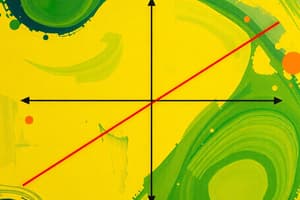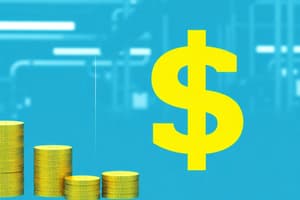Podcast
Questions and Answers
What happens to average and marginal costs when the average product and marginal product are rising?
What happens to average and marginal costs when the average product and marginal product are rising?
- Both average and marginal costs decrease (correct)
- Average cost increases while marginal cost decreases
- Average cost decreases while marginal cost increases
- Both average and marginal costs increase
Average fixed cost remains constant regardless of the level of output.
Average fixed cost remains constant regardless of the level of output.
False (B)
What does U-shaped average and marginal costs imply about production?
What does U-shaped average and marginal costs imply about production?
It implies that costs fall to a minimum and then begin to rise due to the law of diminishing marginal product.
When a firm is experiencing increasing returns to variable inputs, the average and marginal costs are ______.
When a firm is experiencing increasing returns to variable inputs, the average and marginal costs are ______.
Match the following terms with their definitions:
Match the following terms with their definitions:
What is the relationship between cost and price?
What is the relationship between cost and price?
Implicit costs are the payments made to non-owners for resources utilized.
Implicit costs are the payments made to non-owners for resources utilized.
What are explicit costs?
What are explicit costs?
The total fixed cost remains the same regardless of the level of ______.
The total fixed cost remains the same regardless of the level of ______.
Match the following types of costs with their descriptions:
Match the following types of costs with their descriptions:
Which of the following is an example of implicit cost?
Which of the following is an example of implicit cost?
What must a firm at least earn to cover its implicit costs?
What must a firm at least earn to cover its implicit costs?
What happens to total variable cost when the output is zero?
What happens to total variable cost when the output is zero?
Total cost is the sum of total variable cost and total fixed cost.
Total cost is the sum of total variable cost and total fixed cost.
What does AFC stand for in cost analysis?
What does AFC stand for in cost analysis?
As output increases, total variable cost also ____.
As output increases, total variable cost also ____.
Match the costs with their definitions:
Match the costs with their definitions:
Which of the following is a component of total cost?
Which of the following is a component of total cost?
Average Total Cost can only be calculated by dividing total cost by the quantity of output.
Average Total Cost can only be calculated by dividing total cost by the quantity of output.
Provide an example of a variable cost.
Provide an example of a variable cost.
The formula for Average Total Cost (ATC) is ___ = TC/Q.
The formula for Average Total Cost (ATC) is ___ = TC/Q.
Flashcards
Cost Function
Cost Function
The relationship between a firm's output and the cost of producing that output.
Explicit Cost
Explicit Cost
Payments made to non-owners for resources used by a firm (e.g., salaries, materials).
Implicit Cost
Implicit Cost
Opportunity cost of resources owned by the firm (e.g., owner's salary, rent for owned building).
Total Fixed Cost
Total Fixed Cost
Signup and view all the flashcards
Total Variable Cost
Total Variable Cost
Signup and view all the flashcards
Cost
Cost
Signup and view all the flashcards
Price
Price
Signup and view all the flashcards
Marginal Cost (MC)
Marginal Cost (MC)
Signup and view all the flashcards
Average Cost (AC)
Average Cost (AC)
Signup and view all the flashcards
U-shaped Cost Curves (TC, ATC, AVC)
U-shaped Cost Curves (TC, ATC, AVC)
Signup and view all the flashcards
Diminishing Marginal Returns
Diminishing Marginal Returns
Signup and view all the flashcards
Average Fixed Cost (AFC)
Average Fixed Cost (AFC)
Signup and view all the flashcards
Total Cost
Total Cost
Signup and view all the flashcards
Fixed Cost
Fixed Cost
Signup and view all the flashcards
Variable Cost
Variable Cost
Signup and view all the flashcards
Average Total Cost (ATC)
Average Total Cost (ATC)
Signup and view all the flashcards
Average Variable Cost (AVC)
Average Variable Cost (AVC)
Signup and view all the flashcards
Marginal Cost
Marginal Cost
Signup and view all the flashcards
Relationship between TC, TFC, and TVC
Relationship between TC, TFC, and TVC
Signup and view all the flashcards
How is ATC calculated?
How is ATC calculated?
Signup and view all the flashcards
Unit Costs
Unit Costs
Signup and view all the flashcards
Study Notes
Cost Function
- Cost is the expense of producing a product or service.
- Price is what a customer pays.
- Cost directly affects price and profit.
- Cost function describes the relationship between output and production cost.
- Cost includes input prices multiplied by the quantity of inputs.
- Economic cost is more than just historical cost; it includes opportunity cost (the value of the next best alternative use of resources).
Types of Cost
- Explicit costs: Payments to non-owners for resources (salaries, materials).
- Implicit costs: Opportunity costs of resources owned by the firm (entrepreneur's salary, building rent). Total implicit cost = $300,000
Cost Based on Variation with Production
- Total fixed costs: Costs for fixed resources (buildings, machinery, insurance). Does not change with output level.
- Total variable costs: Costs that change with the level of output; (labor, utilities, raw materials).
Unit Cost
- Total cost (TC): Total fixed cost + Total variable cost.
- Average total cost (ATC): Total cost / Quantity of output.
- Average fixed cost (AFC): Total fixed cost / Quantity of output.
- Average variable cost (AVC): Total variable cost / Quantity of output.
- Marginal cost (MC): Change in total cost from producing one more unit.
- Average cost curves are U-shaped (falling, then rising).
- Marginal cost curves intersect (cross) Average cost curve at the minimum point of average cost.
- When marginal cost is below average total cost (ATC), ATC falls.
- Marginal cost and average costs are directly related: when MC is below ATC, ATC is decreasing. When MC is above ATC, ATC is increasing.
Relationship Between Average and Marginal Costs
- When marginal cost is below average cost, average cost falls.
- When marginal cost is above average cost, average cost rises.
- Average cost is lowest where it intersects marginal cost.
Relationship Between Cost and Output
- Total variable cost changes directly with the level of output.
- Fixed costs remain the same regardless of output level.
Studying That Suits You
Use AI to generate personalized quizzes and flashcards to suit your learning preferences.




